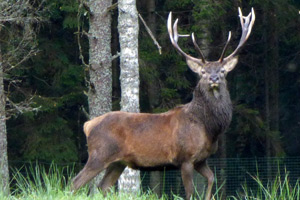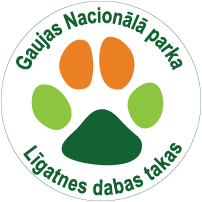Where do they live? Red deer inhabit various forest biomes in Latvia, which are frequently mixed with forest clearings, meadows and agricultural lands. Representatives of the forestry sector and farmers are frequently angry with red deer, since biungulates tend to damage cultures that they have tended with the utmost care.
How do they live? Red deer are family and couple animals, furthermore, they are very conservative - only severe interferences can make them move away from their usual territory. If 6-12 individuals live together, it is impossible to live without a certain hierarchical structure. Only adult males without their herd lead a solitary life.
In autumn, during the mating period of red deer, loud bellowing is often heard in the forests - especially on clear and cold nights. This is the way male deer attract the attention of females, as well as notify their rivals of their strength, might and rights for mating. During the most active mating period, red deer males almost do not eat anything. Mating battles between the strongest bulls tend to be long and cruel.
The fur of newly born calves in spring is spotted with white spots - they are useful to hide in the surrounding environment. The female red deer with calf initially stays separated from the herd, but, when the young has grown up and become stronger to the degree where they can follow the herd, the mother with the calf joins her initial herd. The herd may disperse in autumn as the mating period starts and oldest bulls expel the youngest ones. Later they establish their own groups or herds.
What do they eat? Red deer are herbivores and ruminants - they swallow the food almost whole, without chewing. Later, at moments of rest, they regurgitate the swallowed food and thoroughly chew it to continue the digestion processes in the stomach.
The regurgitated “chewing gum” consists of more than 226 plant species, including different grasses, plant cultures, woody plant species, shrubs, mosses, ferns and fungi.
Did you know?
- Red deer is one of the largest representatives of the deer family in terms of size.
- There are more than 9 subspecies of red deer.
- Red deer are biungulates – when walking, they evenly distribute the weight between the two principal toes (the third and the fourth).
- Red deer predominantly live in family groups or herds.
- During the mating period, red deer males bellow loudly in an attempt to attract the attention of females, as well as notify their rivals of their strength, might and rights for mating.
- There is an opinion that deer antlers rank among the fastest growing bone tissue in the world.
- All animals of deer family have an excellent sense of smell and hearing - they are capable of hearing sounds of much higher frequency than humans.
- Red deer are excellent jumpers and swimmers.
- Members of the deer family keep their noses moist by licking them from time to time. This helps the molecules of smelled substances to better attach to the nose and enables the biungulates to smell the surroundings better.
- Red deer is a popular game animal due to meat and valuable antlers - hunting trophy.
- A very popular feature in the time period from the 18th century to the second half of the 19th century were the deer gardens (breeding enclosures) at manor parks.
- Red deer is the animal of Skåne County in Sweden.
- Cave paintings of deer found in Europe date back more than 40 million years.
- The currency of the United States is often called “bucks” (male of a deer), because in the 18th and 19th century, deer leather was used as currency.
Myths and truth The antlers of male elk already start developing during the first year of life. In adult males the antlers grow from May to July-August. During the growth process, the antlers are comparatively “soft” and covered with young, hairy skin. Later (in the first half of August) the bone crown solidifies and the skin is rubbed off it. Approximately 3 weeks before the beginning of the mating period, in September, the antlers are completely clean. Red deer shed their antlers in the time period from March until May. The number of branches on red deer bull antlers cannot be used to determine their age!
 Red deer (Cervus elaphus)
Red deer (Cervus elaphus)
